- Bernard Preston homepage
- Legumes
- Growing Lima Beans
Growing lima beans
Growing lima beans is not difficult but they have a long season and, unless you love gardening like we do, then the wait for several months and the fag of picking and podding them may be too much.
But it's the only way to get fresh, green limas. You won't find them in the shops but you will see butter beans in cans; not an option for those crazy about the environment.
If you want to reduce your reliance on red meat for protein it means foods
like green beans, chickpeas and lentils; and of course you must grow
limas if you have a large enough vegetable garden.
They are particularly rich in many nutrients like molybdenum (important for diabetics), folate (for lowering homocysteine) and magnesium which is involved in over 300 important reactions in the body.
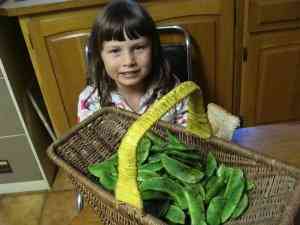
This page was last updated by Bernard Preston on 7th April, 2023.
And in any case, lima beans are delicious, though difficult to get fresh. Grow them instead. Up a lattice work of sticks they are really very easy to plant, and take up little space. Plus, bacteria on the roots of legumes capture nitrogen from the atmosphere for your next vegetable crop.
A soup recipe would use butter beans, which are dried
limas. Fresh and green, straight from the garden is my first choice.
One caution is that growing lima beans is all about slow food. They need a long season, and take time to reap and pod. The only thing that's quick is cooking them.
Oh and eating them, a delicious food, they'll be consumed by the family in a flash, so plan on a large trellis. They make for a surefire gourmet heaven. Add a tad of butter to the hot limas if you are concerned about their starch content but they have a low glycemic index; they do not produce an insulin rush and are not fattening.
New research published in Lancet indicates that the popular low carbohydrate diets are associated with an increased risk of mortality if you get the extra fat and protein from animal-based sources; but lower if you choose rather to enjoy legumes like limas, olive oil and avocados.(1)
You'll need to build a trellis before growing lima beans. The bush type are much less prolific and picking them will break your back.
Most vegetables like full sun, and lima beans are certainly no exception; they simply will not bear in partial shade.
I'm not a great believer in bush beans in general, though they do have their advantages; particularly that they bear much sooner, but less prolifically. All that bending to reap them will keep your chiropractor in business if you are not careful.
Everyone should do lower back exercises
In fact everybody including gardeners should be doing some lower back exercises in any case. They take less than two minutes. Done faithfully every morning before you get out of bed they'll save you a heap of pain; cash in your pocket too. I do them myself.
Here's some interesting research; vigorous rehabilitation exercises were slightly more effective than spinal manipulation by a DC. Anti-inflammatory medication came a distant third in the management of low back pain.
Best of all is a combination of chiropractic and exercise.
So pole lima beans need something to grow on. I've built a trellis of bamboo canes, about three metres long, but a conventional fence would work nearly as well; it is just not quite high enough really.
I am currently experimenting with treated thin wattle poles for a trellis. Building and dismantling the one of bamboo every year is very time-consuming.
Start by digging two trenches, the deeper the better, about one metre apart. Fill them with humus if you've been busy starting a compost pile; your growing lima beans are heavy feeders. Latterly I've just been tipping it on the surface and letting the hens in to find any cutworms.
Press the bamboo canes, or any such support for your lima bean plants, at least eighteen inches into the soft soil in the trenches, about a metre apart; it's not critical.
Later you'll anchor them down properly.
Make the canes cross in a tepee, and then run a long bamboo, lying in the cross, and tie everything tightly with coarse string. I like to put a heavy pole in at each end, say two foot deep, to firmly anchor your trellis.
Once it's laden with your lima bean plants and pods, if a strong wind should spring up, you could lose the lot.
It took me about two hours to build this trellis. It lasted just one season; hence now the experiment using treated poles.
I've gone now for more permanent structures, higher than an average fence and a lot more pricey too, but will hopefully last twenty or more years; yet crop rotation remains important. You can't grow legumes every season in the same place
There's no risk of a garden fence being blown over in a wind storm. Lima beans will grow as high as you make your fence, but reaping them then becomes a problem.
They come from South America by the way and, influenced by the Andes, will grow very tall. Have you got a long ladder?
Growing lima beans
Growing lima beans because you are unlikely to buy them so plant a few instead; it's not difficult.
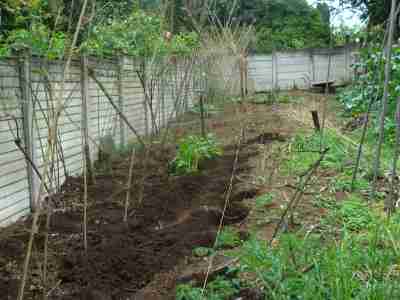
We'll be growing pole beans, sugarsnap peas, butternut, gem squash, lima beans on these fences. Here, she who must be obeyed is preparing the ground for a crop of potatoes. See all the compost she's digging in?
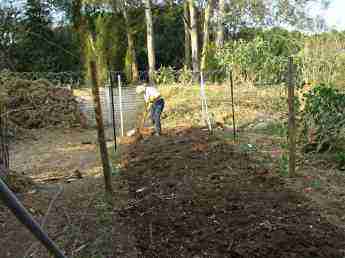
Cheap and easy, the bamboo canes didn't last but they have one great advantage over the fences for growing lima beans seen above. They are movable and you don't grow the same crop every year in the same spot; that's a recipe for disease and pests like the Mexican bean beetle larvae that plague us. We have recently introduced hens to control the bugs and fertilise the ground naturally.
Alternatively building a permanent vegetable garden fence is a good option; but crop rotation is important so I've started using a vegetable garden trellis in addition for our climbers.
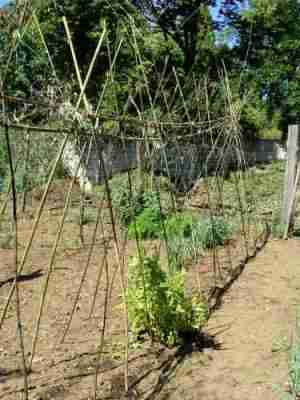
Planting the lima beans is the next step. I like to put in three seeds around each pole, about an inch deep. A cut worm may take one or two.
Newsletter
Our newsletter is entitled "create a cyan zone" at your home, preserving both yourself and Mother Earth for future generations; and the family too, of course. We promise not to spam you with daily emails promoting various products. You may get an occasional nudge to buy one of my books.
Here are the back issues.
- Lifestyle and ideal body weight
- What are ultra-processed foods?
- Investing in long-term health
- Diseases from plastic exposure
- Intensive lifestyle management for obesity has limited value
- A world largely devoid of Parkinson's Disease
- The impact of friendly bacteria in the tum on the prevention of cancer
- There's a hole in the bucket
- Everyone is talking about weight loss drugs
- Pull the sweet tooth
- If you suffer from heartburn plant a susu
- Refined maize meal and stunting
- Should agriculture and industry get priority for water and electricity?
- Nature is calling
- Mill your own flour
- Bake your own sourdough bread
- Microplastics from our water
- Alternative types of water storage
- Wear your clothes out
- Comfort foods
- Create a bee-friendly environment
- Go to bed slightly hungry
- Keep bees
- Blue zone folk are religious
- Reduce plastic waste
- Family is important
- What can go in compost?
- Grow broad beans for longevity
- Harvest and store sunshine
- Blue zone exercise
- Harvest and store your rainwater
- Create a cyan zone at your home
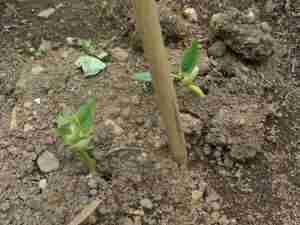
Now you just have to be patient. I started growing these lima beans in mid December (summer in the southern hemisphere). Here are my pole lima beans some 10 weeks later.
The lima bean plants send out fronds in all directions, and they need to be directed periodically, otherwise they break off when they get too heavy in mid-space.
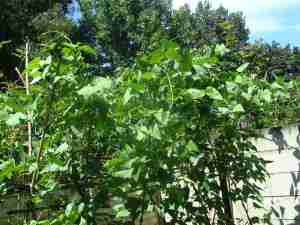
11 weeks after planting the pods are forming. It won't be long before we are enjoying our first green lima beans soup.
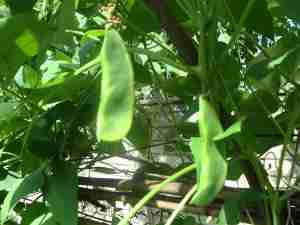
Reaping lima beans
I made the mistake of planting my limas too thickly; max one per stake in the future. They have formed a thick canopy, making picking the beans a slow business. The pods hide amongst the leaves.
An alternative is to transplant extra seedlings to another site when they are established.
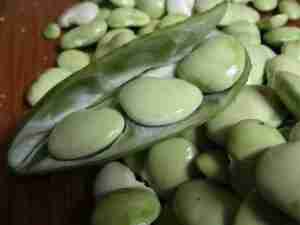
The lima beans is astonishingly prolific; these below all came from one plant, after feeding us several meals. It is a sort of loaves and fishes legume. It is early spring and we are still enjoying the tail end of last summer's crop; they have been bearing continuously for over six months.
We are avid seed collectors; in packets from Mayford they would have cost several hundred dollars.
We are now starting to branch out into the many other varieties of lima beans; I have the seed but they won't be planted until next Spring.
Those are butternut seed in the bottom left corner; keep only the best.
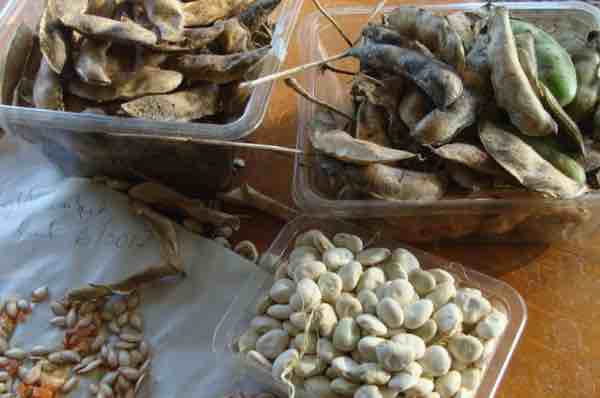
Minimally process plant protein
Much research continues into strategies to reduce red meat consumption. One is minimally processed plant protein; the scientific literature has concerns and so we prefer growing lima beans, and other legumes.
During the summer when there are carbs galore coming from our green garden, we choose to limit starches from bread, porridge and purchased legumes; we have smaller portions.
If you understand how net carbs work you won't be anxious about unprocessed lima beans; it's their fibre content that reduces the glycemic-index.
"It said beef and other bovine product prices declined on weak domestic demand in some leading exporting countries, perhaps reflecting that consumers are switching to cheaper alternatives."
- FAO index, August 2022
Winter
In a mild climate with no severe winters there is no need to pull the plant out of the ground at the end of the growing season. Just prune it back a bit, and it will shoot and bear again in Spring, long before your new seeds will fruit.
I've never kept them more than one extra season; probably they will continue to bear, just at a lower yield. Try it and give me feedback.
Cooking lima beans
It's really very easy, just like cooking ordinary string beans. About five minutes. Cooking lima beans.
- Lower back exercises
Use the Site Search function in the navigation bar above to find the links to those topics like lower back exercises above, and heart stroke diabetes and breast tumours below, highlighted in bold.
Choline
90% of people enjoying typical grocery store food are deficient in choline[5]. It is an essential nutrient so important that it really should be included in the B complex family. It is absolutely vital for the degradation of toxic homocysteine.
Young green lima beans are a particularly rich source of choline. 1 cup contains about 15% of your daily requirement.
Betaine is the important derivative of choline.
"Betaine, a choline derivative, is important because of its role in the donation of methyl groups to homocysteine to form methionine."
- The Journal of Nutrition[7]
Breast tumours and prevention
Growing lima beans means a diet full of breast tumour prevention.
There's a definite association between breast cancer, probably all CA and red meat; so says the World Health Organisation.
That's caste in stone for processed red-meat by the way.
Moving steadily away from red meat, and perhaps even dairy products and
eggs, though there I am yet to be convinced, to legumes for our protein makes sense. It is a true Cyan Zone issue; good for us and especially for the planet too.
Actually it's more about the balance of the meal, as set out up in research published at JAMA and outlined at heart, stroke, and diabetes. Provided you are enjoying your rainbow of colours every day, then in my book you can enjoy some red meat, dairy and eggs; I do.

If you regularly enjoy a lunch plate like this, you need have no guilt with Eggs Florentine for breakfast; and steak, onions and veggies for dinner. Much as I love them, bacon and ham have been relegated to high and holy days. Viennas and polony are totally out; banished for ever. When it comes to mention of malignant breast tumours, every sentence shall contain the word prevention.
The succotash recipe adds a nutritious traditional flavour; grandma would approve, so we should too.
If growing limas is not an option, then enjoy canned butter beans; they're the same thing, only they do not taste nearly so good as straight from the garden.
- Breast tumours and prevention[3]
"Betaine, a choline derivative, is important because of its role in the donation of methyl groups to homocysteine to form methionine."
- The Journal of Nutrition
Legumes in general but especially limas, favas and soybeans are particularly high in an important nutrient called betaine that scientists say 90% of us are deficient in[4]. This shortage results in a build up of a toxic substance called homocysteine; it causes fatty liver and a poor cholesterol profile. We then have to take statins.
We need 500mg of choline from our food. 1 cup of young green lima beans would provide about 15% of our needs.
Growing lima beans is a profoundly important step to greater wellness.
Bernard Preston
Bernard Preston admits he's becoming something of a health nut; all around him he has patients, family and friends dying of tumours. He would rather not join them.
Growing lima beans also means a step in the control of low-grade inflammation in the body; remember that one in four adults will have a stroke.
Growing lima beans in his spare time is just one small part of that fascination for achieving a zestful eighty-plus orbits of the sun. It is Blue Zone longevity that has inspired him; where ten times as many people reach one hundred and vigorous, healthy old age is the norm.
The trick is in the balance; being careful not to submit to becoming a health nut neurotic.
Zestful living
Zestful living is no longer an option for me with relatives and two close friends right now undergoing chemo, one for the second time.
No thank you, I'll stick to these wellness living tips. Will you join me? But growing lima beans is only an option if you are privileged like me to have a garden.
"If you have a garden and a library, you have everything you will ever need."
- Marcus Cicero, Roman politician, lawyer and orator
Usefulness
The usefulness of growing lima beans is a huge step-up to more nutritious and tasty food; you simply cannot get this quality and flavour from the grocery store.
- Dietary carbohydrate intake and mortality
- A short video about the benefits of lima beans.
- Breast cancer and prevention. Web: https://tinyurl.com/4ph8zpk3
- 16 Foods That Are High in Choline
- Choline @ National Library of Medicine
When browsing use right click and "Open Link in New Tab" or you may get a bad gateway signal.
Did you find this page interesting? How about forwarding it to a friendly book or food junkie? Better still, a social media tick would help.
- Bernard Preston homepage
- Legumes
- Growing Lima Beans
Address:
56 Groenekloof Rd,
Hilton, KZN
South Africa
Website:
https://www.bernard-preston.com